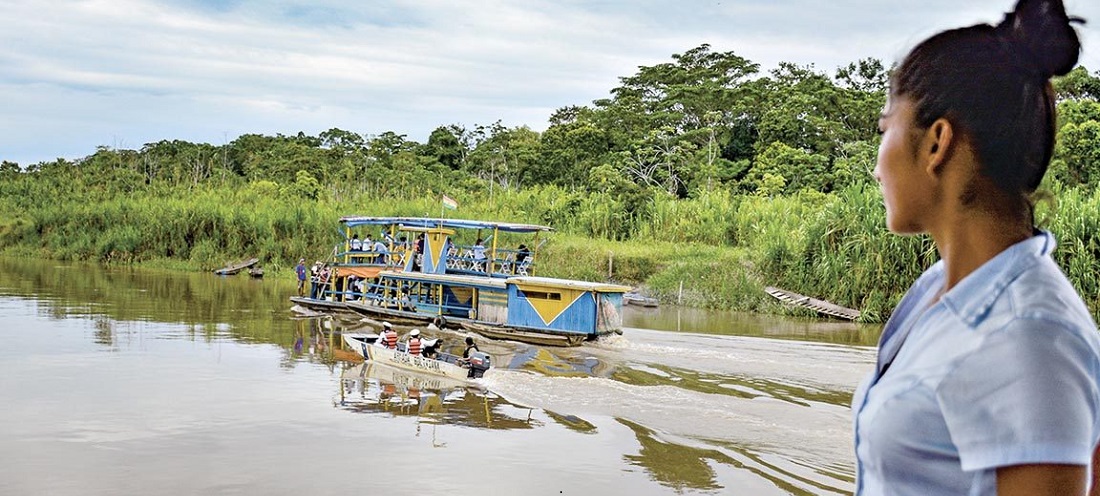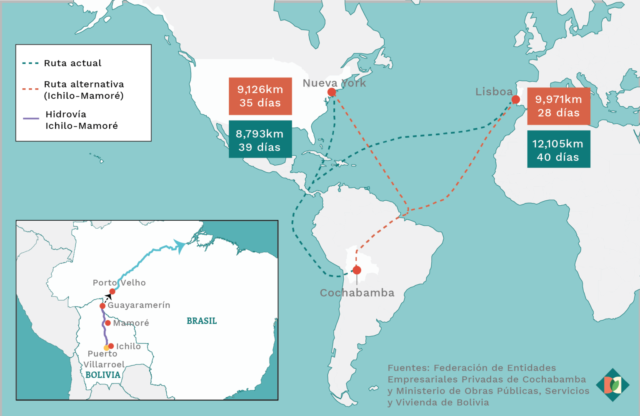
Bolivia eyes foreign trade boost with new aquatic route to the Atlantic
Nov, 08, 2021 Posted by Sylvia SchandertWeek 202143
At the beginning of the War of the Pacific (1879–1884), Bolivia lost its access to the sea. Borders were redrawn and Bolivia’s previous route to the coast fell into Chile’s hands, reducing the now-landlocked nation’s capacity to trade with the rest of the world. In the intervening 142 years, Bolivia has made various attempts to recover its maritime sovereignty and access the Pacific Ocean via Chile or Peru, but without much luck.
As a result, Bolivia has begun to look to the Atlantic with fresh eyes with a new venture: the Ichilo-Mamoré waterway, which Bolivian president Luis Arce formally inaugurated on 5 July. The project, the government says, will improve the passage for larger cargo ships along Bolivia’s Ichilo and Mamoré rivers, the latter of which flows into neighbouring Brazil, where it connects with other waterways that eventually reach the ocean.
Map source: Diálogo Chino
The 1400-kilometre-long infrastructure project starts on a section of the Ichilo river in the Cochabamba department, central Bolivia, and continues along the Mamoré, which flows into the Amazonian region of Beni in the country’s north, on the border with Brazil.
Yet, the Ichilo-Mamoré waterway is not an entirely new project. Efforts to develop the rivers began as early as the 1970s, supported by a cooperation with the Belgian government’s development agency, and the waterway operated relatively regularly until the early 2000s. The project also included the Beni River, which flows north through western Bolivia to meet the Mamoré, with the routes used for domestic transport of fuel and food to remote areas that had no other connections. However, the construction of a road linking the departments of Santa Cruz and Beni in 2001 meant that the waterway ceased to be useful for surrounding populations and shipping companies.
Both natural and social scientists, however, are concerned that the new Ichilo-Mamoré proposal may not be the best choice for a project that brings sustainable and equitable development. They cite some inappropriate hydrological conditions and increased flood risks for riverside communities, along with the need for an environmental impact assessment if the project is to advance.
The Federation of Business Entities of Cochabamba (FEPC) proposed improvements to the Ichilo-Mamoré waterway as a more advantageous route for exporting products to Europe than the one currently used via permits at the Chilean port of Arica, and passing through the Panama Canal to the Atlantic.
At present, goods leaving Cochabamba for Lisbon, for example, travel 12,105 kilometres in 40 days along this route. Goods would reach the same destination in just 28 days travelling along the Ichilo-Mamoré waterway and using existing Brazilian channels. The total length of the journey would be 9,971 kilometres, some 2,300 kilometres fewer.
If it becomes fully operational, the waterway would generate savings of up to 25% in operational export costs, equivalent to US$1 billion dollars per year, according to information provided by the Federation of Private Businessmen of Beni (FEPB). A 2005 study by the Amazon Navigation Improvement Service (Semena) estimated that the revival of the Ichilo-Mamoré waterway would require more than US$100 million.
Bolivia has now begun to raise the necessary funds. In the current, first stage, the Ministry of Public Works (MOPSV) has budgeted a little over US$800,000 for cleaning the waterway, the construction of complementary areas such as warehouses, and for port protection and works supervision. The second phase aims to improve its infrastructure, including signage, road connections, and port platforms at Puerto Villarroel in Cochabamba, where the waterway begins. A third stage seeks to ensure the waterway’s sustainability.
Source:Dialogo Chino
To read the full original article, visit the link: https://dialogochino.net/en/infrastructure/48080-bolivia-seeks-to-boost-foreign-trade-with-ichilo-mamore-waterway/
-
Economy
Apr, 06, 2023
0
South America needs to create conditions for ‘nearshoring’
-
Ports and Terminals
Apr, 25, 2023
0
Port of Salvador to enter new phase with simultaneous operation of docking areas
-
Ports and Terminals
Sep, 23, 2019
0
Port of Fortaleza begins fruit shipments of the 2019-2020 harvest
-
Other Cargo
Sep, 28, 2021
0
ABIMÓVEL: YTD Furniture and mattresses exports up 62.7%



